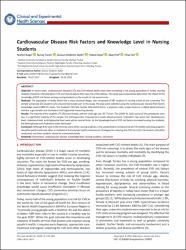| dc.description.abstract | Objective: In recent years, cardiovascular disease (CVD) and CVD-related deaths have been increasing in the young population in Turkey. Nursingstudents should be informed about CVD and should reduce their own risk of this disease. This study was conducted to determine the impact of theknowledge of CVD risk factors among nursing students on the results of risk assessments.Methods: The population of study, which had a cross-sectional design, was composed of 587 students in nursing school at one university. Thesample comprised 351 students who volunteered to take part in this study. The data were collected using the Cardiovascular Disease Risk FactorsKnowledge Level (CARRF-KL) Scale, The Students’ CVD Risk Factors Information Form, a physician scale, a tape measure, a digital blood pressuremonitor, a glucometer and cholesterol and triglyceride measuring devices.Results: The majority of the students (77.2%) were female, and the mean age was 20.77 years. The CARRF-KL Scale scores of the participants werelow. In a significant majority of the sample, the anthropometric measurement results, blood pressure, respiration rate, pulse rate, blood glucoselevel, cholesterol level, and triglyceride level were within normal limits. As the knowledge level of CVD risk factors increased among the students,the blood glucose and cholesterol levels decreased.Conclusion: Although they were in the minority, some of the nursing students in the sample had an increased risk of CVD. Health screening programsshould be performed more often at institutions that educate health professionals. Strategies for reducing the CVD risk in the risk students should beconducted, and these students should be monitored closely. | en_US |



















